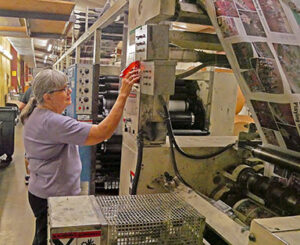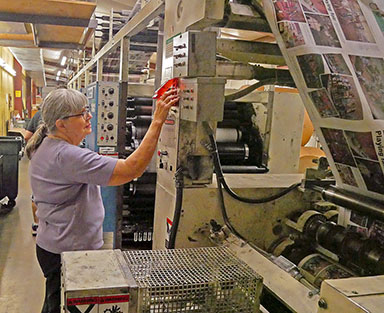By Jordan Green, Editor-in-Chief
Ten years ago, rural newspapers couldn’t get rid of reporters fast enough. Now some can’t find enough reporters to cover even the most routine news stories.
In Wellington, Kansas, the Wellington Daily News — previously owned by Gatehouse Media — laid off staffers and cut the newspaper to a weekly publication starting in 2008, the beginning of a turbulent time in the industry.
As stories went uncovered, readers canceled their subscriptions in droves, and the lone editor’s job became a revolving door of staffers, said Jeremy Gulban, the CEO of the paper’s new parent company, CherryRoad Media.
“We’ve had to do rebuilding,” Gulban said. “We’ve had a hard time finding staff, especially editorial staff, and we’ve had to come up with some creative ideas.”

Gulban’s company isn’t alone. Across the nation, rural newsrooms are struggling to attract and retain credentialed reporters to inform the public about city government, education, breaking news and other happenings, leaving newspapers thinner and remaining staffers stretched to their limits.
Newspapers didn’t always face the challenges they do today. They were the nation’s leading source of news for decades — and they were among its most profitable businesses.
The story of their demise started when the industry was thriving.
NEWSPAPERS FALL
ON HARD TIMES
In 1990, newspapers across the nation had a combined daily circulation of more than 62 million, according to Forbes Magazine. In 2005, annual advertising revenue — the core source of funding for the industry — reached an all-time high of $49.4 billion.
Then came the internet, allowing readers to obtain news for free from thousands of websites. Yet legacy newspaper leaders didn’t see it as a threat. They published their stories online for free rather than charging readers.
“Newspapers tried to adapt to the internet, but it was always done in a way that first and foremost protected the print product,” media analyst Brian Moritz wrote in a 2022 article for Nieman Labs, a news source about the news industry. “The internet was always seen as this extra, bonus thing that complemented the print edition instead of making it the focal point.”
ONLINE ADVERTISING
DOMINATES MARKET;
LAYOFFS ENSUE
Around 2008, companies began buying online advertising more than print advertising, and readers canceled their newspaper subscriptions in favor of free, online outlets. Newspapers across the nation have seen circulation declines in the double-digits or higher ever since. By 2019, print advertising revenue had fallen to $12.45 billion annually — and it fell even more the next year.
“This wasn’t something that happened to newspapers,” Moritz wrote. “It was something that happened because of how newspapers acted.”
As circulation and advertising dollars dwindled, newspapers laid off reporters and editors. The trend has continued for years, forcing some newspapers to shut down and leaving others as mere shadows of their former selves, according to Pew Research Center data.
The number of journalists working at U.S. newspapers fell by 57% between 2008 and 2020 — from more than 70,000 jobs to about 31,000, according to Pew data.
In spite of the financial downfalls, about 7,000 U.S. newspapers remain open, with many in rural areas. But after years of layoffs and low pay, journalists don’t seem to be eyeing jobs at smaller newspapers, creating a problem for the news industry: a lack of people to report the news.
‘NOT A LOT
OF CANDIDATES’
Travis Barnard, editor of the Fairview Republican in Major County in northwest Oklahoma, never intended to be the editor of two weekly newspapers at the same time. But since the editor resigned at the paper’s sister publication — the Cherokee Messenger & Republican — in October 2021, he’s been filling in.
Between the two papers, he’s covering the meetings of multiple school boards and town councils, along with the games of several junior high and high school sports teams. He works up to 13 hours per day to keep both papers running.
“We’ve been trying to find a full-time editor here, but there’s just not a lot of candidates,” Barnard said. “It’s hard to say for sure what the actual cause is.”
The Cherokee and Fairview papers both serve small, rural communities. Cherokee’s population is roughly 1,600, and Fairview’s is about 2,600, according to the U.S. Census.
Attracting degree-holding journalists to the region can be challenging, Barnard said. He has talked to journalism professors at colleges across the state to see if any students would be interested in an editor’s job, but no serious candidates have responded, Barnard said.
Marione Martin knows how it feels to post a job without getting applicants. As the owner of the Alva Review-Courier, a twice-weekly newspaper serving nearby Woods County, she’s tried to hire part-time reporters and photographers in recent years with little success.

Reporting for a smaller publication like the Review-Courier takes a different skill set than reporting for a larger publication does, Martin said. Here, reporters are expected to write stories, capture photos and even help out with back-office duties like compiling legal notices.
Smaller newspapers near larger metropolitan areas have had difficulty hiring news staffers, too.
John Denny Montgomery, co-publisher of the Purcell (Oklahoma) Register in McClain County, said being within an hour of the state’s largest city doesn’t exempt his family’s publication from hiring woes.
“As far as finding reporters and professionals like that, it’s just a difficult market,” Montgomery said. “It’s difficult to find somebody who, for starters, wants to do print journalism in a small town — community journalism. It’s just hard to locate those people. I feel like the colleges and universities really aren’t training the students to even take that route. It seems like most of the training is focused all on the digital side.”
NEWSPAPERS
WITHOUT NEWS
Thousands of U.S. newspapers have closed, but even at newspapers that are still in business, reduced staffing means newspapers aren’t as well-rounded as they once were.
With fewer reporters, a given newspaper can’t cover as many public meetings, report on as many breaking news events or tell as many stories of problems residents may face. As a result, newspapers have less news overall and less impact in their communities.
Researchers at the Hussman School of Journalism and Media at the University of North Carolina, led by media veteran and Professor Penny Abernathy, have coined a term for such publications: “ghost newspapers.”
“Newspapers become ‘ghosts’ when their newsroom staffing is so dramatically pared back that the remaining journalists cannot adequately cover their communities,” researchers wrote. “We estimate, based on news accounts and industry data, at least 1,000 of the 7,200 newspapers still published in this country — and perhaps as many as 1,500 — have lost significantly more than half of their newsroom staffs since 2004. As a result, they have become ghosts, with drastically curtailed reach and journalistic missions.”
The effects of having a ghost newspaper spread throughout the communities they serve. Studies show that communities without a newspaper have lower levels of civic engagement and voter turnout during elections. In some communities, government expenses rise in communities without newspapers.
In 2018, researchers with the Brookings Institute found that municipal bonds increase in towns without a paper, meaning government costs rise — and few, if any, reliable sources investigate how, why or where the money is going.
“The authors speculate that closing local newspapers increase government borrowing costs because (1) less information is publicly available, and (2) local officials are no longer monitored as closely, reducing the quality of governance,” wrote researchers Vivian Lee and David Wessel.
The New York Times, one of the nation’s largest newspapers, has chronicled the plights of some communities where newspapers have shuttered. The publication has told stories that reporters at local outlets weren’t able to finish before they were laid off or their publications closed, elevating local concerns to the national level — and shining a light on what happens when government actions go unreported.
“When hometown papers shutter, the news they once covered — school board updates, city government scandals, high school sports games — often gets lost in a void,” Times editor Lara Takenaga wrote in 2019. “Their role as a community connector also ceases to exist. With no hyperlocal news outlets to replace them, unconfirmed social media posts may be residents’ only source of information.”
FILLING THE VOID
Amid the hardships rural newspapers face in recruiting reporters, some organizations are working to help bring journalists to small communities.
Report for America, a non-profit national service organization, aims to place journalists in newsrooms of all sizes across the United States. Participating journalists can apply to work at newsrooms that agree to “host” them for a period of two to three years, and the organization helps fund the reporter’s salary.
“In all of the communities we work in — we’re in 205 or so newsrooms — we try to help local editors expand their coverage by helping to pay for fantastic local reporters,” said Kim Kleman, the organization’s senior vice president. “In rural areas, there are so many news holes, and often there are news deserts.
That’s where misinformation and disinformation breeds. We are just trying to help local newsrooms cover critically important areas.”
Report for America also hopes to teach local newsrooms how to garner new revenue through community fundraising and philanthropy.
By putting reporters in a community to do quality journalism for two to three years, and teaching editors how to gain support from local donors, the organization hopes its partner publications will have sustainable funding for the future.
“Local newsrooms still have to figure out and improve their business model,” Kleman said. “We at Report for America happen to think that local donations from the community foundation or just from individual subscribers or other readers are a way that you need to make work.”
Other newsrooms are filling their pages by turning to their communities for help. When CherryRoad Media hosted a ribbon-cutting ceremony for a paper it purchased in another Kansas town, a Wellington woman offered to help gather content for the Wellington paper. She also said she would help regain lost community support.
“It’s worked out really well,” Gulban said. “We basically reinvented that paper with her help. Now we’ve found a reporter who is able to cover stories.
“Ultimately, you need to find one person who is local and cares who will make this work.”
Gulban said he believes that helping smaller, rural newspapers make a splash into the digital world — by offering streaming and other digital information and entertainment services — is the key to sustaining community news outlets long-term.
SEEKING OPPORTUNITY?
While pay at smaller weekly and daily newspapers may not draw reporters in, publishers like Montgomery hope reporters will view their outlets as places to develop their skills and learn new ones.
They also hope the allure of being a part of something special can draw reporters in, too.
“Small papers are gritty,” Montgomery said. “We’re determined to put out a good product. We are determined to produce great journalism. And it would be a really good landing spot for somebody who is a serious journalist and really would like to make a difference.”

